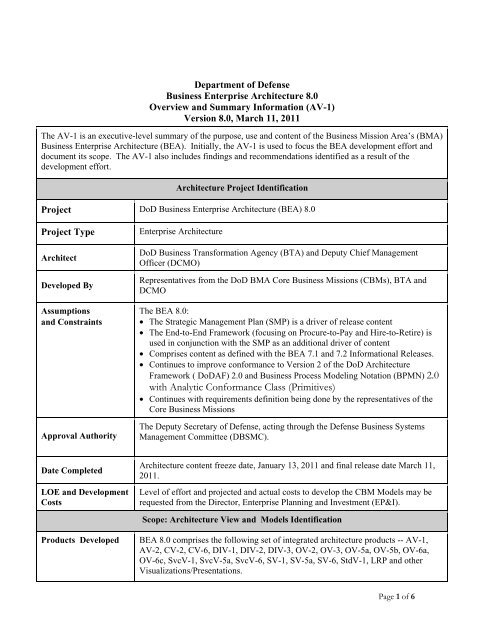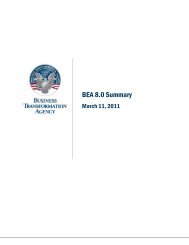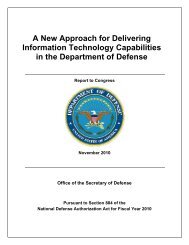AV-1 Overview and Summary Information - Office of the Deputy ...
AV-1 Overview and Summary Information - Office of the Deputy ...
AV-1 Overview and Summary Information - Office of the Deputy ...
Create successful ePaper yourself
Turn your PDF publications into a flip-book with our unique Google optimized e-Paper software.
Department <strong>of</strong> Defense<br />
Business Enterprise Architecture 8.0<br />
<strong>Overview</strong> <strong>and</strong> <strong>Summary</strong> <strong>Information</strong> (<strong>AV</strong>-1)<br />
Version 8.0, March 11, 2011<br />
The <strong>AV</strong>-1 is an executive-level summary <strong>of</strong> <strong>the</strong> purpose, use <strong>and</strong> content <strong>of</strong> <strong>the</strong> Business Mission Area’s (BMA)<br />
Business Enterprise Architecture (BEA). Initially, <strong>the</strong> <strong>AV</strong>-1 is used to focus <strong>the</strong> BEA development effort <strong>and</strong><br />
document its scope. The <strong>AV</strong>-1 also includes findings <strong>and</strong> recommendations identified as a result <strong>of</strong> <strong>the</strong><br />
development effort.<br />
Architecture Project Identification<br />
Project DoD Business Enterprise Architecture (BEA) 8.0<br />
Project Type<br />
Architect<br />
Developed By<br />
Assumptions<br />
<strong>and</strong> Constraints<br />
Approval Authority<br />
Enterprise Architecture<br />
DoD Business Transformation Agency (BTA) <strong>and</strong> <strong>Deputy</strong> Chief Management<br />
<strong>Office</strong>r (DCMO)<br />
Representatives from <strong>the</strong> DoD BMA Core Business Missions (CBMs), BTA <strong>and</strong><br />
DCMO<br />
The BEA 8.0:<br />
• The Strategic Management Plan (SMP) is a driver <strong>of</strong> release content<br />
• The End-to-End Framework (focusing on Procure-to-Pay <strong>and</strong> Hire-to-Retire) is<br />
used in conjunction with <strong>the</strong> SMP as an additional driver <strong>of</strong> content<br />
• Comprises content as defined with <strong>the</strong> BEA 7.1 <strong>and</strong> 7.2 <strong>Information</strong>al Releases.<br />
• Continues to improve conformance to Version 2 <strong>of</strong> <strong>the</strong> DoD Architecture<br />
Framework ( DoDAF) 2.0 <strong>and</strong> Business Process Modeling Notation (BPMN) 2.0<br />
with Analytic Conformance Class (Primitives)<br />
• Continues with requirements definition being done by <strong>the</strong> representatives <strong>of</strong> <strong>the</strong><br />
Core Business Missions<br />
The <strong>Deputy</strong> Secretary <strong>of</strong> Defense, acting through <strong>the</strong> Defense Business Systems<br />
Management Committee (DBSMC).<br />
Date Completed<br />
LOE <strong>and</strong> Development<br />
Costs<br />
Architecture content freeze date, January 13, 2011 <strong>and</strong> final release date March 11,<br />
2011.<br />
Level <strong>of</strong> effort <strong>and</strong> projected <strong>and</strong> actual costs to develop <strong>the</strong> CBM Models may be<br />
requested from <strong>the</strong> Director, Enterprise Planning <strong>and</strong> Investment (EP&I).<br />
Scope: Architecture View <strong>and</strong> Models Identification<br />
Products Developed<br />
BEA 8.0 comprises <strong>the</strong> following set <strong>of</strong> integrated architecture products -- <strong>AV</strong>-1,<br />
<strong>AV</strong>-2, CV-2, CV-6, DIV-1, DIV-2, DIV-3, OV-2, OV-3, OV-5a, OV-5b, OV-6a,<br />
OV-6c, SvcV-1, SvcV-5a, SvcV-6, SV-1, SV-5a, SV-6, StdV-1, LRP <strong>and</strong> o<strong>the</strong>r<br />
Visualizations/Presentations.<br />
Page 1 <strong>of</strong> 6
Scope<br />
Time Frames<br />
Addressed<br />
Organizations<br />
Involved<br />
The scope <strong>of</strong> <strong>the</strong> BEA is any function, process, data, rules <strong>and</strong> LRP that describe<br />
enterprise requirements within <strong>the</strong> Financial Management (FM), Human Resources<br />
Management (HRM), Real Property & Installations Lifecycle Management<br />
(RPILM), Materiel Supply & Service Management (MSSM) <strong>and</strong> Weapon Systems<br />
Lifecycle Management (WSLM) Core Business Missions. The scope <strong>of</strong> new content<br />
for BEA 8.0 focused on refinement <strong>of</strong> enterprise requirements within <strong>the</strong> Hire-to-<br />
Retire <strong>and</strong> Procure-to-Pay E2Es. Additionally, <strong>the</strong>re were refinements made to <strong>the</strong><br />
following st<strong>and</strong>ards: Procurement Data St<strong>and</strong>ard (PDS), Common Human Resources<br />
<strong>Information</strong> St<strong>and</strong>ard (CHRIS) <strong>and</strong> <strong>the</strong> Real Property <strong>Information</strong> Model (RPIM).<br />
The BEA is <strong>the</strong> “To Be” business architecture for transformation efforts at DoD. The<br />
current BEA “To Be” state has intermediate time frames for implementation that are<br />
addressed in <strong>the</strong> Enterprise Transition Plan (ETP). The aforementioned “new<br />
content” or BEA 8.0 accounts for enterprise requirements defined since <strong>the</strong> BEA 7.0<br />
release published on March 17, 2010.<br />
Development <strong>of</strong> BEA 8.0 was facilitated by <strong>the</strong> BTA <strong>and</strong> involved representatives <strong>of</strong><br />
<strong>the</strong> DoD BMA CBMs, led by <strong>the</strong> Principal Staff Assistants (PSAs). The PSAs are<br />
Comptroller, Personnel & Readiness, <strong>and</strong> Acquisition Technology & Logistics. BEA<br />
development was fur<strong>the</strong>r supported by <strong>the</strong> Investment Review Boards (IRBs). The<br />
<strong>Deputy</strong> Chief Management <strong>Office</strong> (DCMO) was also involved as <strong>the</strong> architecture<br />
lead within <strong>the</strong> IRB sessions.<br />
Purpose <strong>and</strong> Viewpoint<br />
Purpose<br />
(Problems, Needs,<br />
Gaps)<br />
Questions to be<br />
Answered<br />
The purpose <strong>of</strong> <strong>the</strong> BEA is to serve as a blueprint for DoD business transformation<br />
<strong>and</strong> to help ensure <strong>the</strong> right capabilities, resources <strong>and</strong> materiel are rapidly delivered<br />
to our warfighters: What <strong>the</strong>y need, where <strong>the</strong>y need it, when <strong>the</strong>y need it, anywhere<br />
in <strong>the</strong> world. The BEA guides <strong>and</strong> constrains implementation <strong>of</strong> interoperable<br />
defense business system solutions as required by <strong>the</strong> National Defense Authorization<br />
Act (NDAA). It is used to support Portfolio Management by being implemented<br />
within <strong>the</strong> BMA investment review process. Each release <strong>of</strong> <strong>the</strong> BEA addresses<br />
BMA enterprise gaps or material weaknesses by having <strong>the</strong>m defined as<br />
requirements that are reflected as BEA content against which investments must<br />
assert compliance.<br />
• How are we investing our funds to best enable <strong>the</strong> warfighting mission?<br />
• How are we investing our funds to best address <strong>the</strong> Business Mission Area<br />
strategic priorities?<br />
• Who are our people, what are <strong>the</strong>ir skills, where are <strong>the</strong>y located?<br />
• Who are our industry partners, <strong>and</strong> what is <strong>the</strong> state <strong>of</strong> our relationship with<br />
<strong>the</strong>m?<br />
• What assets are we providing to support <strong>the</strong> warfighter, <strong>and</strong> where are <strong>the</strong>se<br />
assets deployed?<br />
Page 2 <strong>of</strong> 6
Architecture<br />
Viewpoint<br />
BEA 8.0 was developed from an enterprise level using <strong>the</strong> viewpoint <strong>of</strong> <strong>the</strong> Principal<br />
Staff Assistants (PSAs). As mentioned in <strong>the</strong> Organizations Involved section <strong>of</strong> this<br />
<strong>AV</strong>-1, <strong>the</strong> PSAs are represented by personnel, aligned to <strong>the</strong> CBMs, responsible for<br />
interpreting PSA requirements <strong>and</strong> ensuring <strong>the</strong>y are reflected as enterprise<br />
requirements within <strong>the</strong> BEA. The CBM representatives are guided by <strong>the</strong> SMP <strong>and</strong><br />
<strong>the</strong> E2E framework. The BEA 8.0 <strong>and</strong> subsequent releases continue to enable <strong>the</strong><br />
Department to manage its business from an E2E process perspective.<br />
Context<br />
Mission<br />
Vision<br />
Rules, Conventions,<br />
<strong>and</strong> Criteria<br />
BEA Tasking /<br />
Linkages to O<strong>the</strong>r<br />
Architectures<br />
To be <strong>the</strong> BEA that “shall be sufficiently defined to effectively guide, constrain <strong>and</strong><br />
permit implementation <strong>of</strong> interoperable defense business system solutions” (Title<br />
10>Subtitle A>Part IV>Chapter 131> 2222).<br />
To serve as <strong>the</strong> enterprise blueprint for defining <strong>the</strong> Department’s business<br />
environment. The BEA will continue to be driven by <strong>the</strong> Department’s Strategic<br />
Management Plan (SMP) <strong>and</strong> capture required enterprise capabilities, metrics<br />
aligned to <strong>the</strong> SMP, <strong>and</strong> data st<strong>and</strong>ards <strong>and</strong> rules to permit system <strong>and</strong> web service<br />
interoperability. To be used as a tool for guiding, constraining <strong>and</strong> certifying<br />
business system investments. To also be used as a tool for driving Portfolio<br />
Management <strong>and</strong> business process reengineering via <strong>the</strong> Department’s E2E<br />
Framework.<br />
Rules:<br />
• BEA content is traceable to SMP priorities <strong>and</strong> goals.<br />
• BEA process models are constrained by <strong>the</strong> Business Process Modeling Notation<br />
(BPMN) 2.0 Analytic Conformance Class (Primitives).<br />
• The BEA metamodel continues to migrate to <strong>the</strong> DoDAF 2.0 Metamodel (DM2).<br />
This will be an ongoing process <strong>and</strong> has started with <strong>the</strong> use <strong>of</strong> <strong>the</strong> terms as<br />
outlined in <strong>the</strong> DM2.<br />
Conventions: The conventions <strong>and</strong> methodology to be followed are documented in<br />
<strong>the</strong> BEA Development Methodology <strong>and</strong> <strong>the</strong> Architecture Product Guide (APG)<br />
(e.g., IDEF0, IDEF 1X, BPMN) .<br />
Criteria:<br />
• BEA content is traceable to <strong>the</strong> SMP priorities <strong>and</strong> goals.<br />
• BEA content is guided by <strong>the</strong> SMP <strong>and</strong> <strong>the</strong> E2E Framework.<br />
• Enterprise requirements reflected in <strong>the</strong> BEA are approved by <strong>the</strong> PSAs by way<br />
<strong>of</strong> <strong>the</strong> CBM representatives.<br />
Tasking -- The 2005 National Defense Authorization Act (NDAA) requires that <strong>the</strong><br />
DoD build an “an enterprise architecture…which shall be sufficiently defined to<br />
effectively guide, constrain <strong>and</strong> permit implementation <strong>of</strong> interoperable defense<br />
business system solutions”<br />
Linkages to O<strong>the</strong>r Architectures – Federal Enterprise Architecture (FEA) Business<br />
Reference Model through <strong>the</strong> DoD EA Reference Models; The DoD Joint Capability<br />
Areas (JCAs).<br />
Page 3 <strong>of</strong> 6
Tools <strong>and</strong> File Formats to be Used<br />
IBM Rational System Architect v 10.7, Oracle, MS SQL Server, Enterprise Elements, Army Knowledge<br />
Online/Defense Knowledge Online<br />
Business Enterprise Architecture 8.0 -- Findings <strong>and</strong> Recommendations<br />
Findings<br />
1 Authoritative data st<strong>and</strong>ards, based on common<br />
vocabularies, is a key driver for transformation<br />
efforts across <strong>the</strong> DoD BMA. Development efforts<br />
in BEA 8.0 are focused on data st<strong>and</strong>ardization in<br />
order to implement approved BMA Business<br />
Capabilities through development <strong>of</strong> integrated<br />
DoD business systems.<br />
2 DoDAF 2.0 has as its mantra "fit for purpose" <strong>and</strong><br />
has included a more robust methodology <strong>and</strong><br />
supporting metamodel (i.e., DM2). This version <strong>of</strong><br />
<strong>the</strong> framework continues to have an impact on <strong>the</strong><br />
future direction <strong>of</strong> <strong>the</strong> BEA <strong>and</strong> <strong>the</strong> environment<br />
within which it is developed <strong>and</strong> managed.<br />
Recommendations<br />
Continue to incorporate authoritative data st<strong>and</strong>ards<br />
into <strong>the</strong> BEA as a development priority. Develop a<br />
common vocabulary lexicon based on DoDAF 2.0<br />
metadata <strong>and</strong> BPMN /Primitives concepts to<br />
establish authoritative common terms <strong>and</strong> usage.<br />
Continue to evolve <strong>the</strong> BEA Development<br />
Methodology (BDM), Architecture Product Guide<br />
(APG) <strong>and</strong> <strong>the</strong> BEA development environment to<br />
conform to DoDAF 2.0. The changes to <strong>the</strong><br />
metamodel will impact <strong>the</strong> representation <strong>of</strong><br />
architecture content, architecture usage, <strong>and</strong> <strong>the</strong> tools<br />
used to develop <strong>the</strong> content <strong>and</strong> visualization.<br />
Additionally, address how to support <strong>the</strong> DoDAF 2.0<br />
Physical Exchange Specification (PES) in BEA 9.0<br />
3 Current BEA structure <strong>and</strong> content does not fully<br />
support <strong>the</strong> BEA’s statutory use <strong>of</strong> permitting<br />
implementation <strong>of</strong> interoperable business system<br />
solutions. It also needs to be improved from<br />
methodology, tool <strong>and</strong> content perspectives to<br />
better support federation.<br />
4 The addition <strong>of</strong> DIV-3 products into <strong>the</strong> BEA<br />
raises <strong>the</strong> need to clarify <strong>the</strong>ir intended use to <strong>the</strong><br />
larger BEA audience. From a RPILM perspective,<br />
<strong>the</strong> DIV-3 products can ei<strong>the</strong>r be rigid, based<br />
st<strong>and</strong>ards or more flexibly derived st<strong>and</strong>ards. The<br />
latter position meaning that while <strong>the</strong> DIV-3 is<br />
based on st<strong>and</strong>ards, it only represents one <strong>of</strong> many<br />
possible implementation schemas that can be<br />
derived from those st<strong>and</strong>ards.<br />
Adopt <strong>and</strong> implement a methodology to capture <strong>and</strong><br />
make available BEA content that enables solution<br />
developers to “build federation into <strong>the</strong>ir solutions”<br />
through use <strong>of</strong> semantic ontologies <strong>and</strong> open source<br />
technologies.<br />
Recommend fur<strong>the</strong>r development <strong>of</strong> DIV-3 guidance<br />
in <strong>the</strong> next iteration <strong>of</strong> <strong>the</strong> Architecture Product<br />
Guide (APG) to cover topics such as usage.<br />
Page 4 <strong>of</strong> 6
Findings<br />
4 There continues to be unresolved issues with<br />
multiple instances <strong>of</strong> <strong>the</strong> same terms <strong>and</strong><br />
descriptions used generically across <strong>the</strong> different<br />
functional communities. The evolving central<br />
information repositories for decision makers are<br />
highly dependent on consistent <strong>and</strong> universal<br />
concepts <strong>and</strong> related definitions. Issues arising<br />
from conflicting terminology impacts efforts<br />
toward architecture federation <strong>and</strong> building a<br />
common business vocabulary.<br />
Recommendations<br />
BTA will lead <strong>the</strong> BEA 8.1workshop efforts to<br />
address <strong>the</strong> remaining inconsistencies <strong>and</strong><br />
ambiguities in procurement related data attributes<br />
<strong>and</strong> descriptions in order to advance <strong>the</strong> concepts <strong>of</strong><br />
a common business vocabulary.<br />
5 Synchronized Predeployment <strong>and</strong> Operational<br />
Tracker (SPOT) functionality within <strong>the</strong> HRM<br />
models have been represented at a macro level<br />
within BEA 8.0. The content still requires fur<strong>the</strong>r<br />
decomposition to document detailed functional<br />
requirements in <strong>the</strong> architecture.<br />
6 The Planning, Programming <strong>and</strong> Budgeting<br />
portions <strong>of</strong> <strong>the</strong> architecture requires additional<br />
work. After <strong>the</strong> Quadrennial Defense Review<br />
(QDR) is completed, extensive work is required to<br />
ensure that PPB is represented at level that is<br />
sufficient to show how Department-wide execution<br />
is linked to plans <strong>and</strong> programs.<br />
7 BEA does not include processes, activities, or data<br />
objects related to <strong>the</strong> commercial sales process.<br />
8 To ensure consistency <strong>and</strong> alignment <strong>of</strong> E2E <strong>and</strong><br />
BEA processes, gaps identified between <strong>the</strong>se<br />
products should be addressed. Additionally, <strong>the</strong><br />
mappings <strong>of</strong> <strong>the</strong> E2E process flows to <strong>the</strong> BEA are<br />
inconsistent.<br />
Additional workshop discussions need to be<br />
conducted within BEA 8.1 to explore how more<br />
details <strong>of</strong> contractor <strong>the</strong>ater oversight can be<br />
integrated within <strong>the</strong> BEA while also displaying<br />
similar levels <strong>of</strong> detail for <strong>the</strong> oversight <strong>of</strong> o<strong>the</strong>r<br />
human resources.<br />
Following <strong>the</strong> completion <strong>of</strong> <strong>the</strong> Quadrennial<br />
Defense Review, an extensive business process<br />
reengineering effort should be scheduled in a future<br />
BEA release.<br />
A joint Financial Management/Acquisition<br />
Technology <strong>and</strong> Logistics (AT&L) business process<br />
reengineering effort <strong>of</strong> <strong>the</strong> sales process should be<br />
scheduled for a future BEA release.<br />
A st<strong>and</strong>ard approach on how to align <strong>the</strong>se two<br />
products is critical to support <strong>the</strong> development <strong>of</strong><br />
enterprise st<strong>and</strong>ard requirements <strong>and</strong> to have an<br />
implementable BEA.<br />
Page 5 <strong>of</strong> 6
Findings<br />
Recommendations<br />
9 Define gaps between E2E processes <strong>and</strong> <strong>the</strong> BEA. The E2E development <strong>and</strong> refinement efforts in BEA<br />
8.0 helped identify additional gaps between previous<br />
release’s <strong>of</strong> <strong>the</strong> E2E content <strong>and</strong> current release.<br />
These additional areas for refinement resulted from<br />
<strong>the</strong> identification <strong>of</strong> E2E flows that were previously<br />
part <strong>of</strong>, but no longer fit in <strong>the</strong> revised H2R <strong>and</strong> P2P<br />
models. The gaps are referred to in this document as<br />
Orphan Process steps <strong>and</strong> are identified as follows:<br />
H2R:<br />
• Military Health Services<br />
• Manage Travel<br />
• Law Enforcement<br />
• Physical Security<br />
• Safety<br />
• Interagency Support<br />
• Policy <strong>and</strong> Guidance<br />
P2P:<br />
• Manage Travel<br />
10 BEA staff recommends a review <strong>of</strong> Capabilities in<br />
<strong>the</strong> End to End Framework to determine how best<br />
to establish <strong>and</strong> manage an enterprise set <strong>of</strong> DoD<br />
Capabilities.<br />
Gaps should be addressed in near term releases <strong>of</strong><br />
<strong>the</strong> BEA.<br />
Fur<strong>the</strong>r coordination with <strong>the</strong> DCMO <strong>and</strong> Joint Staff<br />
is required to determine <strong>the</strong> purpose <strong>and</strong> use <strong>of</strong><br />
Capabilities within <strong>the</strong> E2E Framework. Also<br />
efforts need to be identified to incorporate <strong>the</strong> BEA<br />
Business Capabilities into <strong>the</strong> Joint Capability Areas<br />
(JCAs) enabling <strong>the</strong> creation <strong>of</strong> a set <strong>of</strong> Enterprise<br />
Capabilities across <strong>the</strong> DoD.<br />
Page 6 <strong>of</strong> 6




